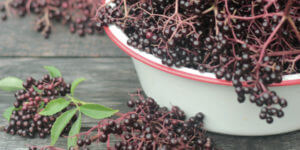Elderflowers and Elderberries
 For lovers of elderflowers, early summer is a happy time. The large white flowering umbels frost elder shrubs with pollen-laden blossoms, a magnet for honeybees and other pollinators. They are also irresistible to foragers: While Sambucus species can be an ornamental boon to the gardener, their real reward is for the cook and the home-brewing alchemist.
For lovers of elderflowers, early summer is a happy time. The large white flowering umbels frost elder shrubs with pollen-laden blossoms, a magnet for honeybees and other pollinators. They are also irresistible to foragers: While Sambucus species can be an ornamental boon to the gardener, their real reward is for the cook and the home-brewing alchemist.I encounter two elderberries in the Northeast: S. nigra and S. canadensis (which is also viewed as a subspecies of S. nigra). Other Sambucus species, like the West Coast S. nigra subsp. caerulea with blue fruit, can be used in the same ways, although their flavor will be different (and better by some accounts). I have no personal experience with the red-fruited species of Sambucus, but the drupes are edible once cooked. Yes, despite their common name, the fruit is really a drupe, not a berry. Elderdrupes just does not sound the same.
Elderflowers bloom around the time that peak serviceberry season is drawing to a close in my hood. They induce a kind of giddiness in foragers. Their flavor, released into syrups and infusions, is unique, and they taste better in translation than they smell in bloom. Summer is not summer without a fizzing jar of elderflower cordial on the brew.
For the fruit, cooking is key. Despite their gorgeously glossy appearance when ripe, these fruits’ raw flavor is unimpressive. Also, the raw fruit can make some people sick. But something magical happens with heat as well as with fermentation. A cupful of relatively bland, raw elderberry juice (I do not recommend drinking it) brought to a boil for a few minutes turns darkly complex. Ripe fruit covered with sugar and allowed to ferment for days or weeks becomes bright and assertive. Even unripe green fruit—considered very toxic—is rendered edible by fermentation, as the Nordic Food Lab has taught us. Elderberry syrup is a proven therapy for colds and flu—it has antiviral and anti-influenza properties, among others.
How to Collect and Prepare
Remember that when you pick the flowers, you are depriving the plant of fruit. If you want fruit later, leave as many umbels behind as you take. Once you are home, spread them out to encourage any small insects to leave. Do not wash the flowers or you will lose precious pollen and wild yeast.
Elderberries are one of the easiest fruits to pick en masse and quite quickly. By the time they are very ripe, their stems snap easily. In good years their umbels are loaded with juicy fruit, and it requires little effort to carry several pounds home.
Once you have the fruit, you need to detach it from its stems. A quick way to do this is to freeze the whole umbels. Stick a bagful of fruit in the freezer for a couple of hours. Once frozen, they drop off very easily. The drawback here is that the very thin stems to individual fruits also break off easily and you end up with more stem matter than if you pick the fruit off fresh and unfrozen. If you need to use the fruit raw for fermentations, it is also better not to freeze the elderberries, as freezing will kill some helpful wild yeasts. It takes me about an hour (and something good on Netflix) to process 5 pounds of unfrozen fruit. Freezing will take half the time.
The Goo: Crushing elderberries, raw or cooked, releases a fascinating, rubbery substance that will coat your implements—usually only the part that is constantly in contact with the juice and seeds from elderberries under pressure. When the fruit is raw, the gum is clear to beige, and when cooked it is green. To clean your equipment, first rinse it, then dry it with a paper towel. Coat the surface generously with mineral oil. Leave for 10 minutes and wipe with paper towels, newspaper, cotton wool pads, or old pieces of cloth (that you never want to use again). Coat with oil again and repeat. When The Goo is gone, scrub the clean equipment with a soapy sponge and hot water (I prefer a nailbrush to dislodge the snags of the cotton wool pads I use). Good as new.
Caution
All green parts of elderberry are considered toxic. Raw ripe fruit also can be toxic in certain doses (different for everyone), so eat it with caution. Cooked is fine. If taking elderberry syrup as a medicine, do not consume more than 3 tablespoons per day. I have had a mild allergic reaction to it (skin rash). Never eat raw green elderberries unless they have been fermented first.
Bug Slayer
Makes 1 bug-slaying drink
Elderberries have proven antiviral properties, and I keep a jar of syrup on hand purely for dosing purposes if the Frenchman or I feel under the weather. The same jar delivers a very good mixer—astringent, sweet, very elder. Shaking it up with Elderberry Gin and lemon juice, I can hear the flu run, screaming. It’s a hot-pink drink. Pink is your friend.
Ingredients
3 fluid ounces (6 tablespoons) Elderberry Gin
1 fluid ounce (2 tablespoons) Cooked Elderberry Syrup
1 fluid ounce (2 tablespoons) lemon juice
